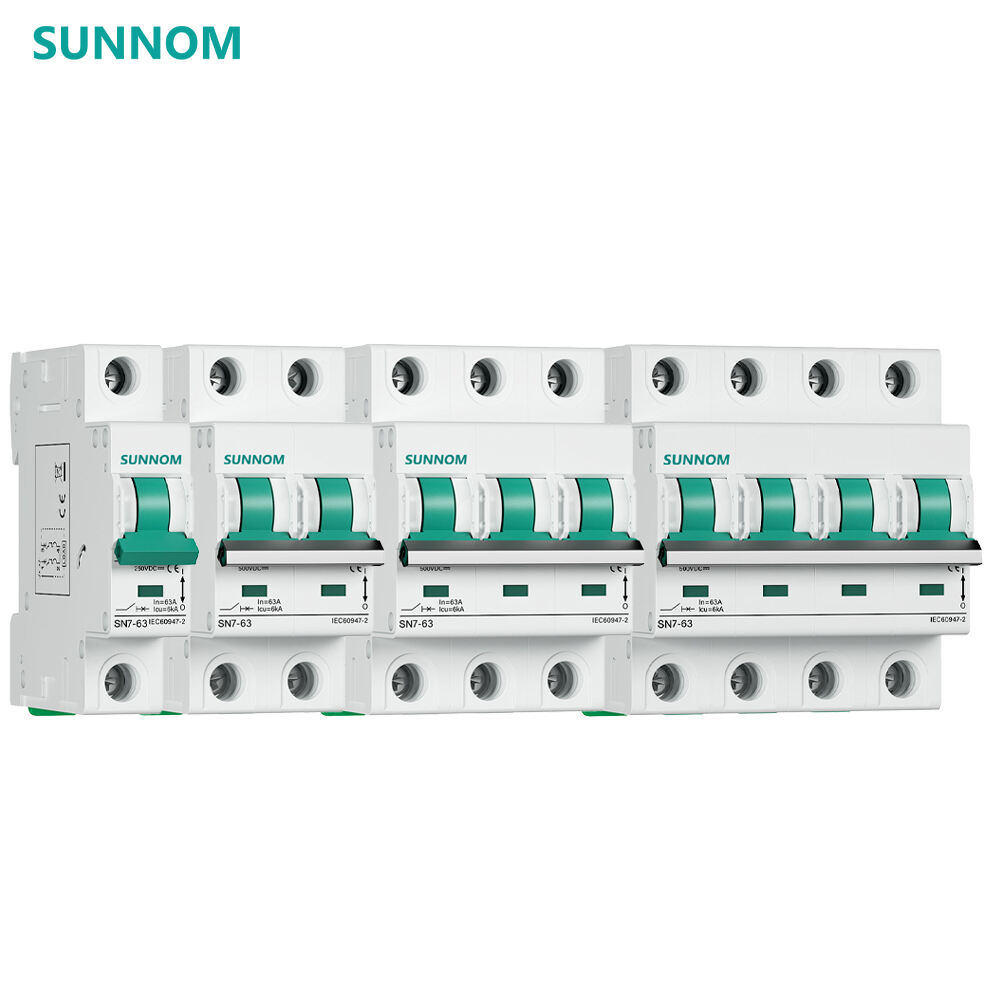Solar photovoltaic systems require specialized protection equipment to ensure safe and reliable operation throughout their lifespan. Among the most critical components are DC circuit breakers, which serve as the primary safeguard against overcurrent conditions, short circuits, and electrical faults in direct current applications. Unlike their AC counterparts, these devices must handle the unique challenges presented by DC power systems, including the absence of natural current zero crossings that complicate arc extinction. Understanding the key factors involved in selecting appropriate DC circuit breakers is essential for system designers, installers, and maintenance professionals working with renewable energy installations.

Understanding DC Circuit Breaker Fundamentals
Operating Principles and Arc Extinction Challenges
DC circuit breakers operate on fundamentally different principles compared to AC devices due to the continuous nature of direct current flow. In AC systems, the current naturally crosses zero twice per cycle, providing opportunities for arc extinction. However, DC current maintains a constant flow direction and magnitude, making arc interruption significantly more challenging. Modern DC circuit breakers employ sophisticated arc extinction techniques including magnetic blowout systems, SF6 gas insulation, or vacuum technology to effectively interrupt fault currents.
The arc extinction process in DC applications requires careful consideration of contact materials, chamber design, and cooling mechanisms. Magnetic blowout systems use electromagnetic forces to stretch and cool the arc, while vacuum interrupters eliminate the arc medium entirely. Understanding these operating principles helps engineers select devices that can reliably interrupt fault currents under various system conditions and environmental factors.
Current Interruption Ratings and Capabilities
The current interruption capability represents one of the most critical specifications for DC circuit breakers in photovoltaic applications. This rating defines the maximum fault current that the device can safely interrupt without sustaining damage or compromising system integrity. PV systems can generate substantial fault currents, particularly in large installations with multiple parallel strings, making proper interruption rating selection crucial for personnel safety and equipment protection.
Modern DC circuit breakers are available with interruption ratings ranging from several hundred amperes to tens of thousands of amperes, depending on the application requirements. The selection process must account for maximum prospective fault currents, system growth potential, and safety margins to ensure reliable protection throughout the system's operational life.
Voltage Rating Considerations for PV Applications
Maximum System Voltage Requirements
Photovoltaic systems operate at various voltage levels depending on their configuration, from residential installations at several hundred volts to utility-scale projects exceeding 1500V DC. The voltage rating of DC circuit breakers must exceed the maximum system voltage by appropriate safety margins to prevent insulation breakdown and ensure reliable operation. This includes consideration of temperature coefficients, aging effects, and transient overvoltages that may occur during system operation.
System voltage calculations must account for open-circuit voltages under various temperature conditions, as PV module voltages increase significantly in cold weather. The selected circuit breaker voltage rating should provide adequate margin above the maximum expected system voltage, typically 125% or higher, to accommodate these variations and ensure long-term reliability.
Insulation Coordination and Clearance Requirements
Proper insulation coordination ensures that DC circuit breakers can withstand both normal operating voltages and transient overvoltages without breakdown. This involves selecting devices with appropriate basic insulation levels, clearance distances, and creepage paths suitable for the operating environment. Outdoor installations face additional challenges from pollution, moisture, and UV exposure that can degrade insulation performance over time.
The insulation system must maintain its integrity throughout the expected service life while accommodating thermal cycling, mechanical stress, and environmental exposure. Modern DC circuit breakers incorporate advanced insulation materials and designs that provide enhanced performance in challenging outdoor environments typical of solar installations.
Current Rating and Thermal Management
Continuous Current Capacity Selection
The continuous current rating of DC circuit breakers must be carefully matched to the expected load currents in photovoltaic systems. This rating represents the maximum current that the device can carry indefinitely without exceeding specified temperature limits. Proper sizing requires analysis of maximum power point currents, temperature derating factors, and potential overload conditions that may occur during system operation.
PV systems typically operate at currents well below their maximum capability most of the time, but peak generation conditions combined with high ambient temperatures can stress circuit protection devices. The selection process should consider current multiplication factors, thermal derating requirements, and coordination with upstream and downstream protection devices to ensure optimal system performance.
Temperature Derating and Environmental Factors
Environmental conditions significantly impact the current-carrying capacity and performance of DC circuit breakers in solar applications. High ambient temperatures, direct solar radiation, and enclosed installation environments can reduce the effective current rating of protection devices. Manufacturers provide derating curves that specify how current capacity varies with temperature, humidity, and altitude conditions.
Proper thermal management involves not only selecting appropriately rated devices but also ensuring adequate ventilation, heat dissipation, and protection from direct solar exposure. This may require oversizing devices, providing forced cooling, or implementing thermal monitoring systems to maintain safe operating conditions throughout the system's operational life.
Selectivity and Coordination Requirements
Upstream and Downstream Protection Coordination
Effective protection coordination ensures that faults are cleared by the protection device closest to the fault location, minimizing system disruption and maintaining power delivery to unaffected circuits. This requires careful analysis of time-current characteristics, fault current magnitudes, and device operating speeds to achieve proper selectivity throughout the system protection scheme.
DC circuit breakers must coordinate with fuses, other circuit breakers, and electronic protection systems to provide reliable fault discrimination. The selection process involves analyzing fault current distribution, device operating characteristics, and system topology to ensure that protection devices operate in the correct sequence during fault conditions.
Arc Flash and Personnel Safety Considerations
Arc flash hazards represent a significant safety concern in DC power systems, requiring careful consideration during circuit breaker selection and system design. The energy release during arc flash events can cause severe injuries and equipment damage, making proper protection device selection and installation practices critical for personnel safety.
Modern DC circuit breakers incorporate arc flash mitigation features including rapid fault clearing, current limiting capabilities, and enhanced arc extinction systems. The selection process should consider incident energy calculations, personal protective equipment requirements, and maintenance safety procedures to minimize arc flash risks throughout the system's operational life.
Installation and Maintenance Considerations
Mounting and Connection Requirements
The physical installation of DC circuit breakers requires careful attention to mounting methods, connection techniques, and environmental protection. Proper mounting ensures mechanical stability, adequate heat dissipation, and protection from environmental factors that could compromise device performance. Connection methods must provide low resistance, high reliability joints that can withstand thermal cycling and mechanical stress over the system's operational life.
Installation practices should follow manufacturer recommendations and industry standards for torque specifications, conductor sizing, and environmental sealing. Proper installation directly impacts device performance, reliability, and safety throughout the system's operational life, making adherence to established procedures essential for successful solar installations.
Maintenance and Testing Protocols
Regular maintenance and testing of DC circuit breakers ensures continued reliable operation and early detection of potential problems. Maintenance programs should include visual inspections, electrical testing, mechanical operation checks, and replacement of consumable components as recommended by manufacturers. The frequency and scope of maintenance activities depend on environmental conditions, system utilization, and device specifications.
Testing protocols for DC circuit breakers may include insulation resistance measurements, contact resistance checks, timing tests, and operational verification under various load conditions. These activities help identify degradation trends, verify proper operation, and schedule preventive maintenance before failures occur that could compromise system reliability or safety.
Standards and Certification Requirements
International Standards Compliance
DC circuit breakers for photovoltaic applications must comply with relevant international standards that specify performance requirements, testing procedures, and safety criteria. Key standards include IEC 60947-2 for low-voltage switchgear, UL 489 for molded case circuit breakers, and IEC 62548 for photovoltaic arrays. Compliance with these standards ensures that devices meet minimum performance and safety requirements for their intended applications.
Standard compliance involves extensive testing and certification processes that verify device performance under various operating conditions, fault scenarios, and environmental exposures. Understanding applicable standards helps engineers select devices that meet regulatory requirements and provide reliable protection throughout their service life.
Certification and Testing Verification
Third-party certification provides independent verification that DC circuit breakers meet specified performance and safety requirements. Recognized testing laboratories conduct comprehensive evaluations including electrical performance, mechanical endurance, environmental exposure, and safety verification testing. These certifications provide confidence in device performance and facilitate regulatory approval processes.
The certification process involves rigorous testing protocols that simulate real-world operating conditions, fault scenarios, and environmental exposures. Understanding certification requirements and selecting certified devices helps ensure compliance with applicable codes and standards while providing reliable protection for photovoltaic installations.
FAQ
What is the typical lifespan of DC circuit breakers in solar applications
DC circuit breakers in photovoltaic systems typically have operational lifespans ranging from 20 to 30 years when properly selected, installed, and maintained. The actual lifespan depends on environmental conditions, operating duty, fault frequency, and maintenance practices. Regular inspection and testing can help identify when replacement is necessary to maintain system reliability and safety.
How do environmental conditions affect DC circuit breaker performance
Environmental factors significantly impact DC circuit breaker performance through temperature effects on current capacity, UV degradation of polymer components, moisture ingress affecting insulation, and corrosive atmospheres attacking metal components. Proper selection includes considering temperature derating, environmental sealing, and UV-resistant materials to ensure reliable operation throughout the expected service life.
What maintenance is required for DC circuit breakers in PV systems
Maintenance requirements for DC circuit breakers include regular visual inspections for signs of overheating or damage, periodic electrical testing of insulation and contact resistance, mechanical operation verification, and cleaning of contact surfaces and insulation. The frequency depends on environmental conditions and manufacturer recommendations, typically ranging from annual to every few years depending on the specific application and operating conditions.
Can AC circuit breakers be used in DC applications
AC circuit breakers should not be used in DC applications because they are not designed to handle the unique challenges of DC current interruption. DC current lacks the natural zero crossings that facilitate arc extinction in AC systems, requiring specialized arc interruption techniques. Using AC devices in DC applications can result in failure to interrupt fault currents, leading to equipment damage and safety hazards.




